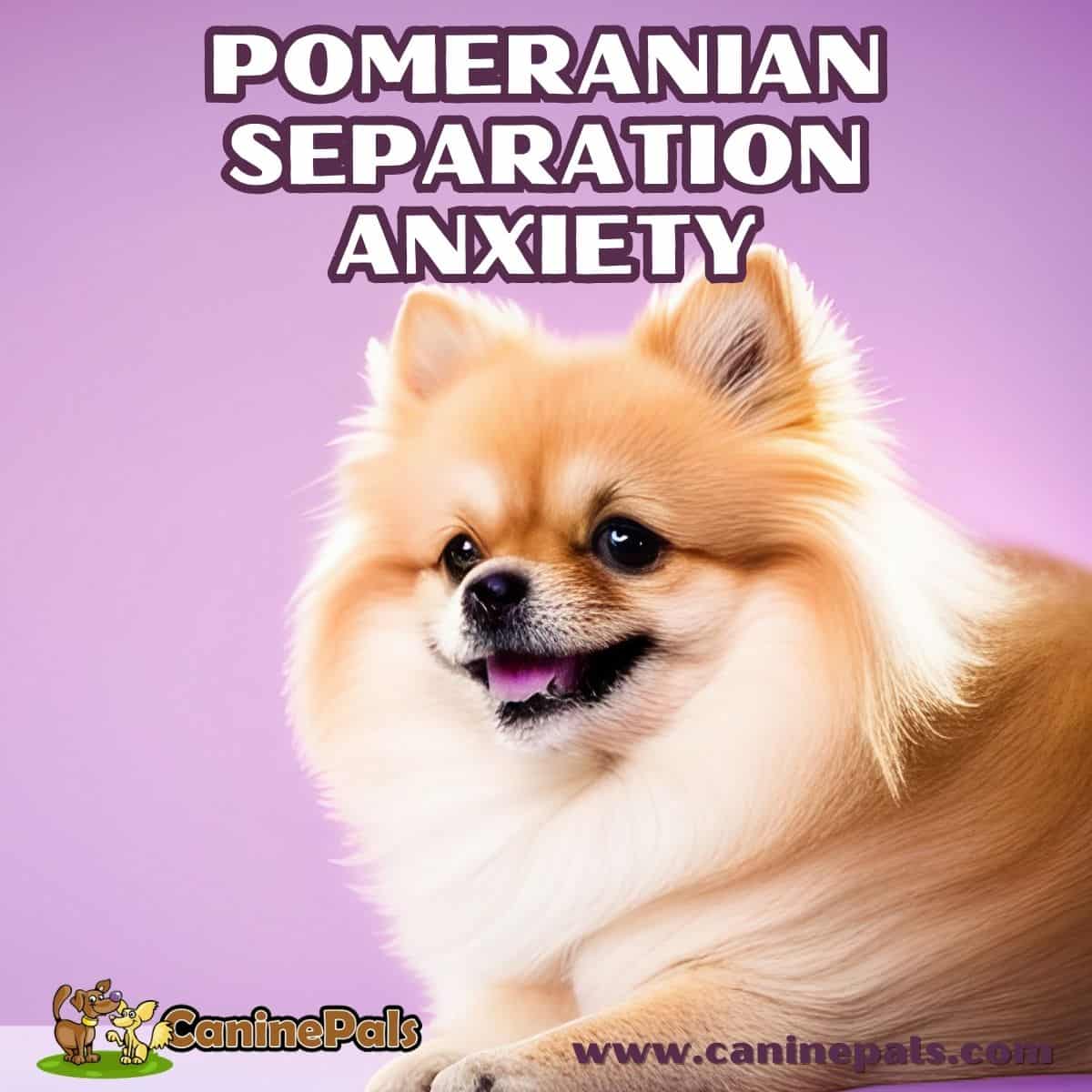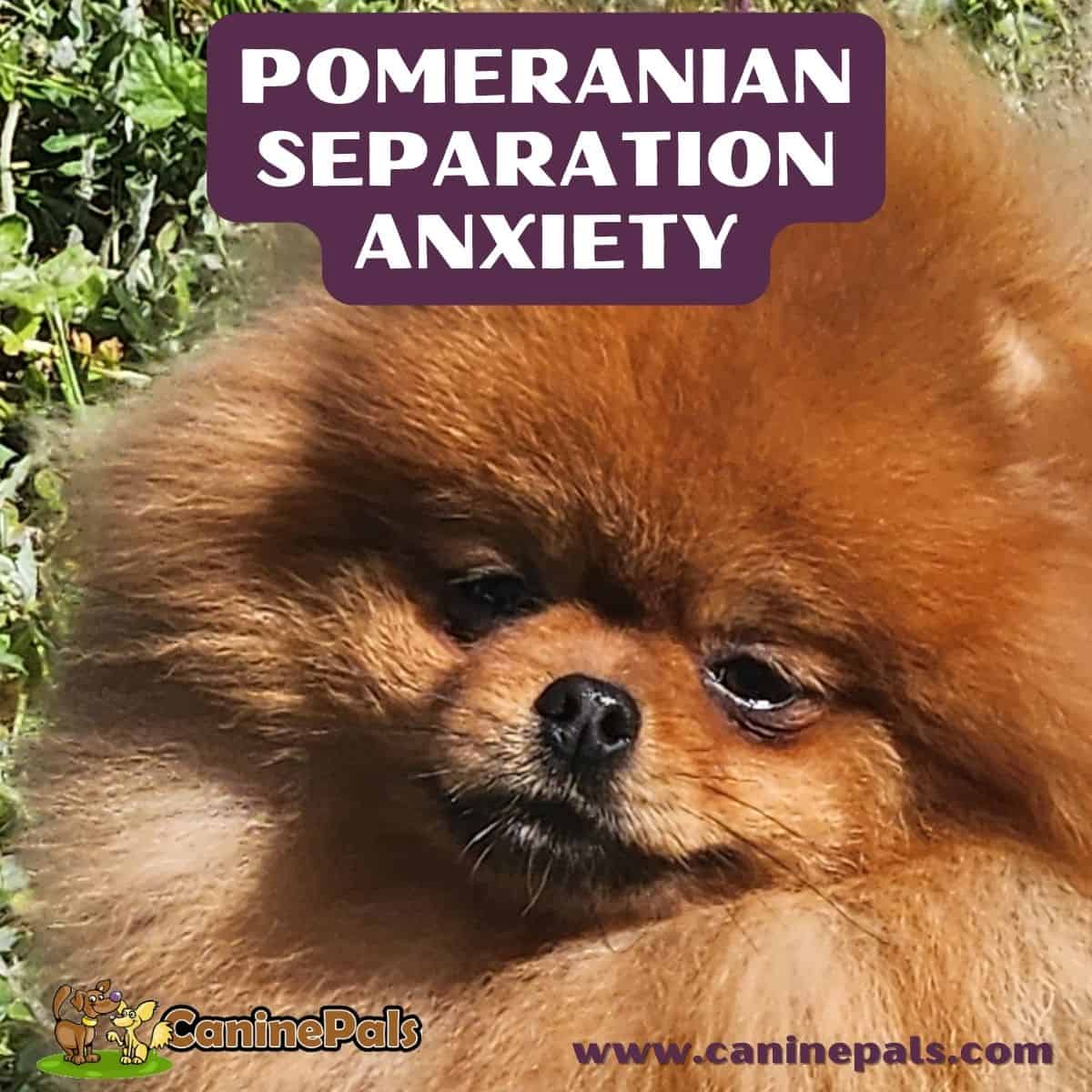Last Updated on March 20, 2024 by Denise Leo. Post first published on September 1, 2023.
As a Pomeranian owner, it is important to understand that Pomeranians are prone to separation anxiety. Separation anxiety is an issue that occurs when dogs become extremely stressed and anxious when left alone.
Pomeranian Separation Anxiety can lead to destructive behavior, excessive barking, and other problematic behaviors. Pomeranians are known for their close bond with their owners. Anxiety is a common issue among dogs when they are left alone by their owners.
This issue can be especially challenging for owners who work outside the home or have other commitments that require them to leave their Pomeranian alone for extended periods. Learn how to identify and address separation anxiety in your Pomeranian to keep them content and thriving.
Key Takeaways
- Pomeranians are prone to separation anxiety, a behavioral issue that can lead to destructive behavior and excessive barking.
- Learn how to recognize and effectively deal with separation anxiety in your beloved Pomeranian to ensure their well-being and happiness.
- Training, exercise, and medication can all effectively manage Pomeranian separation anxiety.

Understanding Separation Anxiety
Understanding separation anxiety, a common issue affecting many dogs, is important. Anxiety is a common condition in dogs where they feel anxious or scared when they are left alone.
Possible causes of this behavior can include fear, past trauma, or situations that remind the dog of a negative experience. Some of the signs of separation anxiety in Pomeranians include anxious behavior, such as pacing, whining, barking, or howling.
They may also become destructive, chewing on furniture or other objects, urinating, or defecating, even if they are otherwise house-trained. Other signs of separation anxiety may include excessive licking, scratching, or chasing their tail.
It is important to note that separation anxiety does not result from disobedience or a lack of training. This condition is serious and demands the owner to exercise patience and understanding. If you suspect that your Pomeranian is suffering from separation anxiety, seek help from a veterinarian or professional dog trainer, which is essential for the well-being of your furry companion.
There are many causes of anxiety in Pomeranians. Some dogs may develop separation anxiety due to a traumatic experience, such as abandonment or mistreatment. Others may be genetically predisposed to stress, while others may develop separation anxiety due to a lack of socialization or training.
To help your Pomeranian overcome separation anxiety, it’s crucial to pinpoint the underlying cause of the issue. To effectively address your dog’s unique needs, it’s important to collaborate with a skilled dog trainer or behaviorist who can create a personalized training plan.
This tailored approach will help ensure success in modifying your dog’s behavior. In some cases, medication may also be necessary to help manage your dog’s anxiety. Overall, it is important to be patient and understanding when dealing with separation anxiety in Pomeranians.
Helping your furry friend overcome anxiety is possible with the right approach, love, and patience. Learn practical steps to provide a happy and healthy life for them.
Pomeranian: A Breed Overview
As a Pomeranian breeder and owner, I can confidently say that this dog breed is one of the most adorable and loyal companions you can ever have. Pomeranians are small dogs that belong to the toy group of dog breeds. They are known for their fluffy and thick coats, which come in white, black, orange, and cream colors.
Pomeranians are a popular dog breed, and it’s easy to see why. They are friendly, playful, and affectionate dogs that make great family pets. They are also known for their intelligence and trainability, which makes them ideal for first-time dog owners.
One thing to note about Pomeranians is that they are prone to anxiety, especially separation anxiety. They are a very social breed and thrive on human interaction.
Pomeranians love to be around their owners, and when they are left alone for extended periods, they can become anxious and distressed. In terms of health concerns, Pomeranians are generally healthy dogs.
However, they are predisposed to certain health issues such as dental problems, luxating patella, and tracheal collapse. It’s important to keep up with regular veterinary check-ups to ensure that your Pomeranian is healthy and happy.
Overall, Pomeranians are a wonderful breed that can bring much joy and love into your life. They are loyal, intelligent, and affectionate dogs that make great companions.
However, it’s important to know their predisposition to anxiety and take steps to prevent and manage it.

Pomeranian Separation Anxiety Signs
As a Pomeranian owner, it’s essential to recognize the signs of separation anxiety in your furry friend. Separation anxiety is a common issue that many Pomeranians face and it can cause stress and discomfort for you and your pet.
Here are some common signs of Pomeranian separation anxiety that you should look out for:
Barking, Howling, and Whining
One of the most common signs of separation anxiety in Pomeranians is excessive barking, howling, and whining. Your pet may bark or howl for hours on end, even if there’s no one around. This behavior can result from your pet feeling anxious or stressed when you’re not around.
Chewing and Destructive Behaviors
Another common sign of separation anxiety is destructive behavior such as chewing, digging, and destructive chewing. Your Pomeranian may chew on furniture, shoes, or anything else they can get their teeth on. This behavior results from your pet feeling anxious or stressed when you’re not around.
Pacing and Licking
Your Pomeranian may also pace, lick excessively, or show other signs of agitation when you’re not around. These behaviors result from your pet feeling anxious or stressed when you’re not around, which can signify separation anxiety.
Urinating and Defecating
In severe cases, your Pomeranian may also urinate or defecate in the house when you’re not around. This behavior results from your pet feeling anxious or stressed when you’re not around, which can signify separation anxiety.
Recognizing the signs of anxiety in your beloved Pomeranian is crucial for addressing and resolving this common issue.
If you notice any of these signs, it’s essential to help your pet feel more comfortable and secure when you’re not around.
Health Issues Related to Separation Anxiety
As a Pomeranian parent, I know separation anxiety can negatively affect my dog’s health. When a Pomeranian experiences separation anxiety, they may exhibit physical and emotional symptoms that can lead to health problems.
One common physical symptom of separation anxiety is trembling. Pomeranians may shake or tremble when left alone, which can signify physical stress.
This can also lead to other health problems, such as urinary tract infections (UTIs), which separation anxiety can cause.
In addition, Pomeranians with separation anxiety may exhibit frantic behavior, such as clawing at doors or gates, which can lead to injuries or other physical problems. They may also urinate or defecate in inappropriate places, which can cause health problems and be difficult to clean up.
Separation anxiety can also emotionally affect Pomeranians, leading to depression and other health problems. It is important to reduce the stress caused by separation anxiety to avoid these negative effects on your dog’s health.
To reduce stress and promote your Pomeranian’s health, there are several things you can do. Walking your dog before you go out can alleviate their restlessness and decrease their stress. Providing toys or treats can also help distract them and reduce stress.
Separation anxiety can negatively affect your Pomeranian’s physical and emotional health.
Promote your dog’s happiness and well-being by reducing stress and creating a healthy environment. Here’s how you can make it happen.
Training and Exercise for Pomeranians
Providing your furry friend with proper training and exercise is important to prevent separation anxiety. Training can help your Pomeranian become more independent and confident, while exercise can help them release excess energy and reduce stress.
Training your Pomeranian should start with basic commands such as “sit” and “stay.” These commands can help your Pomeranian learn self-control and discipline, which can help them cope with separation anxiety. It is important to be consistent with training and utilize positive reinforcement techniques, such as rewarding with treats and praise, to train effectively.
In addition to basic commands, mental stimulation can also benefit Pomeranians. Keep your dog’s mind sharp and anxiety-free with engaging activities like puzzle toys and obedience training.
Exercise is also important for Pomeranians. Walking is a great exercise to help them release energy and reduce stress.
It is important to start with short walks and gradually increase the length and intensity of the walks. Socialization is also important for Pomeranians.
Regular walks help them interact with other dogs and people, making them more confident and independent.
Overall, training and exercise are essential for preventing separation anxiety in Pomeranians. You can help your furry friend become more independent and confident, reducing tension and stress by providing proper training, mental stimulation, and exercise.
To reduce stress and promote your Pomeranian’s health, there are several things you can do. Walking your dog before you go out can alleviate their restlessness and decrease their stress. Providing toys or treats can also help distract them and reduce stress.
Managing Pomeranian Separation Anxiety
Seeing your Pomeranian experience separation anxiety can be heartbreaking as a dog owner. The good news is that there are several things you can do to help manage this common issue and make your furry friend feel more comfortable when you’re away.
One of the most important things you can do is establish a routine. Dogs thrive on routine, so try to set a schedule for feeding, exercise, and playtime. This can help your Pomeranian feel more secure and less anxious when you’re not around.
Another helpful tip is to desensitize your Pomeranian to your departure cues. This can include picking up your keys or putting on your shoes. Start by doing these things without actually leaving, and gradually work up to going for short periods of time.
This can help your Pomeranian learn that these cues sometimes mean you’re leaving for a long time.
You can also use a Thundershirt or other calming garment to help your Pomeranian feel more secure. These garments work by applying gentle pressure to your dog’s body, which can help reduce anxiety.
If you have a clingy Pomeranian, consider hiring a dog sitter or walker to keep them company in your absence. This practical solution can give them the attention they crave and ensure they are well cared for.
This can help give your Pomeranian some much-needed socialization and attention, reducing anxiety.
For severe cases of separation anxiety in your Pomeranian, seeking professional help is crucial. An animal behaviorist or veterinarian possesses the expertise to diagnose and address any underlying behavioral issues contributing to this problem. Don’t hesitate to reach out for assistance in ensuring your furry friend’s well-being.
Remember, managing your Pomeranian’s separation anxiety may take time and patience. With the right approach, you can ensure your furry friend feels comfortable and secure even when you’re not there.
Medication and Supplements for Anxiety Relief
When it comes to Pomeranian separation anxiety, medication, and supplements can be effective in providing relief. However, it’s important to note that medication should only be used as a last resort and under the guidance of a veterinarian.
One popular anti-anxiety supplement for dogs is CBD oil. It has been shown to have a calming effect on dogs and help reduce anxiety.
Want a natural way to help your dog relax? Look no further than chamomile! This supplement is known for its stress-reducing benefits for our furry friends. It has a calming effect and can help soothe an anxious dog.
L-tryptophan and L-theanine are amino acids that can also effectively reduce anxiety in dogs.
These compounds boost the levels of serotonin and dopamine, crucial neurotransmitters that play a significant role in mood regulation.
Ginger root is another natural supplement that can help reduce anxiety in dogs. The substance possesses anti-inflammatory qualities that can provide relief for gastrointestinal discomfort.
Severe separation anxiety may require medication to alleviate symptoms effectively. A veterinarian typically prescribes these medications, which should only be used under their guidance.
Some common medications used to treat separation anxiety in dogs include fluoxetine, clomipramine, and alprazolam.
In addition to supplements and medication, other products can help reduce anxiety in dogs. Pheromone diffusers like Thunderease release calming pheromones to help soothe an anxious dog.
These diffusers are easy to use and can be placed in any room in the house.
Overall, medication and supplements can be effective in reducing Pomeranian separation anxiety. However, consulting a veterinarian before using any medicine or supplement is important.
A healthy life for your Pomeranian is important, and finding the right treatment for their anxiety can help them live a happier, more relaxed life.
Technological Aids for Separation Anxiety
It can be tough to leave your furry friend at home alone. Separation anxiety in dogs is a common issue that can lead to destructive behavior and other problems.
Luckily, several technological aids can help ease your Pomeranian’s anxiety while you’re away.
One popular option is a pet cam or dog cam. These cameras allow you to check in on your pet remotely through your smartphone or computer.
Some even have two-way audio so you can talk to your dog and offer reassurance. This can be a great way to ease your dog’s anxiety and give yourself peace of mind.
Another option is a radio or other background noise. Many dogs find comfort in hearing human voices or soothing music; leaving a radio on can help ease their anxiety. You can also leave the TV on or play a calming playlist on your phone.
Consider a playpen or other enclosed space if your Pomeranian is particularly anxious. This can help limit their access to areas of the house where they might be tempted to chew or scratch. It can also give them a sense of security and help them feel more comfortable while you’re away.
Several high-tech solutions, such as treat-dispensing cameras and interactive toys, are also available. These devices allow you to interact with your dog remotely and offer treats or playtime as a reward for good behavior.
While expensive, they can be a great way to keep your dog entertained and help ease their anxiety.
Overall, there are many technological aids available to help ease your Pomeranian’s separation anxiety. Whether you opt for a pet cam, radio, playpen, or high-tech gadget, finding a solution that works for you and your furry friend is important.
Expert Tips to Prevent Separation Anxiety in Pomeranians
Separation anxiety can be distressing for both the Pomeranian and their owner. But worry not; we’ve got you covered! Here are some practical tips to help prevent separation anxiety in your furry friend.
- Gradual Departures: Ease your Pomeranian into being alone by gradually increasing your time away. Start with short absences and progressively extend them. This allows them to adjust and build confidence.
- Create a Safe Space: Designate a specific area in your home where your Pomeranian feels secure and comfortable. Set up their bed, toys, and favorite blanket in this space to create a calming environment.
- Tackle Boredom: Keep your furry pal entertained in your absence. Provide interactive toys, treat puzzles, or music to distract and engage them. Mental stimulation can alleviate anxiety and boredom.
- Calm Departures and Arrivals: Avoid making a big fuss when you leave or return home. Act cool and composed, as if it’s a routine. This helps your Pomeranian understand that departures and arrivals are no big deal.
- Counter-Conditioning: Associate departures with positive experiences. Offer treats or small rewards when you leave, gradually increasing the time between rewards. This conditions your Pomeranian to associate your absence with positive outcomes.
- Enlist Help: Ask a trusted neighbor, friend, or professional dog sitter to check in on your Pomeranian during longer absences. Having someone drop by can provide companionship and break up the monotony.
- Consistency is Key: Establish a consistent daily routine for your Pomeranian. Regular feeding, exercise, and playtime can provide a sense of security, reducing their anxiety.
Remember, every Pomeranian is unique, so it may take trial and error to find what works best for your furry friend. By implementing these expert tips, you’ll be well on your way to preventing separation anxiety and ensuring a happier, more relaxed Pomeranian.
Frequently Asked Questions
Can Pomeranians be left outside?
It is recommended to leave Pomeranians only briefly, especially in extreme weather conditions. Pomeranians are indoor dogs and prefer the company of their owners. Leaving them outside for too long can cause them to become anxious and stressed.
Do Pomeranians bark a lot?
Pomeranians are known to be vocal dogs and may bark more than other breeds. However, excessive barking may indicate separation anxiety or other issues. Proper socialization and training can help reduce excessive barking.
Are Pomeranians hard to potty train?
Potty training a Pomeranian can be challenging, but it is not impossible. Consistency and positive reinforcement are key. Crate training and establishing a regular schedule can also help with potty training.
How do I teach my Pomeranian to be alone?
Teaching a Pomeranian to be alone takes time and patience. Start by leaving them alone for short periods and gradually increasing the duration. Please provide them with toys and treats to keep them occupied. Avoid making a big deal out of leaving or returning home.
How do you calm a stressed Pomeranian?
Calming a stressed Pomeranian can be done by providing a safe and comfortable environment, playing relaxing music, and using calming pheromone sprays. Consult with a veterinarian if your Pomeranian’s stress levels persist.
What are some tips for preventing anxiety in Pomeranians?
Preventing separation anxiety in Pomeranians involves proper socialization and training from a young age. Gradually exposing them to being alone and rewarding good behavior can also help prevent separation anxiety. Providing toys and treats can also keep them occupied while you are away.

Conclusion
In conclusion, Pomeranian separation anxiety can be managed by taking the proper steps. It is important to first educate yourself on the signs and symptoms of separation anxiety to identify the issue correctly.
After identifying the problem, some preventative measures can be taken to reduce possible triggers, such as providing plenty of exercise, socialization, mental stimulation, a secure place for your pup to retreat, and desensitization training.
If it persists, consulting the aid of a professional may be beneficial. Understanding and applying these methods can help curb any anxieties that arise in your pup when left alone.
So don’t despair if your puppy has started showing signs of distress—take proactive steps now to support their emotional well-being!
Copyright CaninePals.Com. All Rights Reserved.
References and Further Reading:
- Official Standard of the Pomeranian (AKC). American Kennel Club, 2011.
- Official English Kennel Club Pomeranian Breed Standard, 2017.
- Kimbering Pomeranians “1891-1991”.
- Denise Leo, The Pomeranian Handbook.
- L.Ives, Show Pomeranians.
- L.Ziegler Spirer & H.F. Spirer, This is the Pomeranian.
- FEDERATION CYNOLOGIQUE INTERNATIONALE (FCI) German Spitz, including Keeshond and Pomeranian Breed Standards. PDF file.


